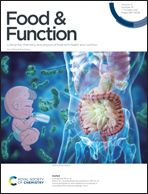The effects of fermented rye products on gut microbiota and their association with metabolic factors in Chinese adults – an explorative study†
Abstract
Rye is among the cereals with the highest content of dietary fibre. A high rye food intake has been associated with improved metabolic risk factors in some but not all observational and intervention studies. Whole-grain rye has also been suggested to affect the gut microbiota in individuals with metabolic syndrome. However, it is yet unclear to what extent effects on the gut microbiota mediate the beneficial metabolic responses of whole-grain rye intake. We hypothesized that a high intake of whole grain rye products containing fermented rye bran (FRB) vs. refined wheat based products (RW) could alter the gut microbiota and short-chain fatty acid (SCFA) composition towards a phenotype associated with beneficial metabolic effects in a population not used to such foods. For this purpose, we conducted a post hoc analysis of a 12-week randomized controlled trial in Chinese adults with Helicobacter pylori (HP) infection, with 53 participants consuming RW and 31 participants consuming FRB included in the analysis. Anthropometric measurements and fasting blood and fecal sample analyses as well as 13C-urea breath test were performed at baseline and after a 12-week intervention. At week 12, we observed a higher serum insulin concentration (P-value = 0.038) in the FRB group (n = 31) versus the RW group (n = 53), and this difference was corroborated with alterations in the genus-level relative abundances of the gut microbiota, represented by an increase in Romboutsia and a reduction in Bilophila in the FRB group (n = 22) versus the RW group (n = 46). Compared to the RW group (n = 53), fecal acetic acid concentration was significantly higher in the FRB group (n = 31) at week 12. We also found that fecal acetic and butyric acids positively, while isobutyric, isovaleric and 2-methylbutyric acids inversely, correlated with the gut Romboutsia level among all participants (n = 68) at week 12. We found positive correlations of fecal isobutyric, isovaleric and 2-methylbutyric acids with gut Bilophila (n = 68). In conclusion, our results suggest that the intake of high-fibre rye products could modify gut Romboutsia and Bilophila in a Chinese population with HP infection. These effects are paralleled with favorable modifications of the SCFA concentration and are associated with altered glycemic traits.



 Please wait while we load your content...
Please wait while we load your content...